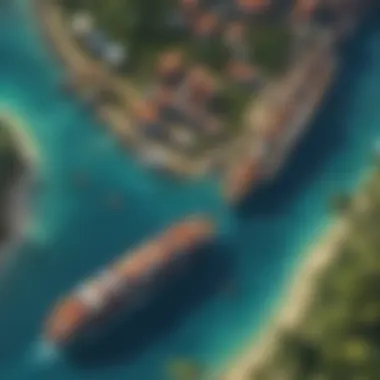Shipping Dynamics in Tropical Regions: Challenges & Opportunities


Intro
This article delves into the complex nature of shipping in tropical regions, emphasizing both the unique obstacles and possibilities these areas present. It addresses geographical features, varying climates, and significant economic factors influencing maritime operations. Understanding these elements is essential for stakeholders aiming to thrive in an arena characterized by opportunities and challenges alike.
Understanding Tropical Geography
Tropical regions are known for their diverse geographical attributes. From islands like Indonesia and the Philippines to coastal nations in Africa and South America, the shipping routes are rich and varied. While these routes offer potential for trade, they also hinder traffic due to unpredictable precipitation patterns, striking whirlwinds, and intricate coastal topographies.
Tropical shipping routes are critical for global trade, impacting both local economies and international markets.
Climatic Challenges
The tropical climate introduces heavy rain, stormy waters, and high humidity. These factors can significantly delay shipments. Instances of monsoons or hurricanes necessitate careful planning, raising the stakes for timing and managing inventory. Effective weather forecasting becomes paramount.
Economic Dynamics
The economic aspects surrounding tropical shipping show a dual nature. On one hand, there’s a demand for tropical goods, often leading to lucrative opportunities for exporters. On the other, delays can incur costs and impact reliability. Navigating through these nuances is crucial for gaining a competitive edge.
Strategic Importance of Shipping Routes
The shipping routes through tropical areas hold substantial strategic value. Not only do they connect pivotal markets, they also serve as conduits for a variety of goods. Commodities ranging from textiles to raw materials often rely on these passes for distribution.
Infrastructure and Logistics
Investing in modern ports and efficient logistics systems enhances the shipping experience. Upgrading facilities ensures faster turnaround times and bolsters overall trade capabilities. Effective logistics can mitigate some of the obstacles faced in these regions.
Global Trade Implications
Tropical shipping routes play a critical role in enhancing global trade. With advancements in technology, ways to deal with challenges have improved over the years. Stakeholders must remain adaptable and consistently review their strategies to maintain competitiveness in an ever-evolving market.
By understanding these intricate elements, industry players can cultivate a more tactical approach to shipping in the tropics, ultimately fostering a robust environment conducive to trade and cohesion.
Preface to Tropical Shipping
Shipping plays a crucial role in connecting tropical regions with global markets. Tropics are not just rich in biodiversity, they also provide significant resources that are essential for international trade. The essentiality of this connectivity can not be underestimated, particularly as these regions often act as gateways for economic activities between continents.
Understanding the Tropical Environment
The tropical environment is unique. It includes regions that experience a warm climate throughout the year, showcasing a diverse ecology. Characteristics such as varied rainfall patterns and temperature fluctuations create specific nuances for shipping operations.
Navigating through these waters presents distinct challenges and advantages. For instance, dense vegetation may cause visibility issues, while certain tidal patterns impact docking and delivery schedules. Further, the prevalence of natural disasters like hurricanes can lead to operational disruptions, prompting the need for innovative management strategies in logistics.
Protecting the intricate ecosystems is equally vital. This can involve assessments and regulation plans to mitigate environmental impacts. Understanding the unique landscape is essential for shipping companies aiming to optimize routes and enhance efficiency while being environmentally responsible.
The Economic Significance of Tropical Shipping
The economic dynamics invigorated by tropical shipping cannot be overlooked. These regions contribute extensively to the global trade supply chain. From agricultural goods to vital minerals and energy resources, tropical areas fuel many industries.
One primary benefit of tropical shipping includes access to diverse products with lower transit times. Local economies thrive as shipping companies generate job opportunities linked directly to port activities and transportation services. Furthermore, these operations enhance infrastructure development, paving the way for more substantial foreign investment.
In addition to local benefits, tropical shipping supports international connections, facilitating exports from developing economies. The role of professional shipping services in ensuring safe, compliant, and efficient transport directly correlates to the prosperity of local and regional markets.
"Effective shipping in tropical regions is not just about transportation. It’s interwoven with local economic growth and sustainability."


This interconnectivity addresses numerous challenges of the global market necessitating adaptive strategies from shippers willing to engage meaningfully within tropical environments. Understanding these dynamics allows stakeholders to navigate complexities with better insight and preparedness.
Geographical Considerations
Geographical considerations play a critical role in understanding the dynamics of shipping in tropical regions. This area is characterized by its unique trade routes, port infrastructure, and environmental features that can significantly impact logistical operations. A thorough comprehension of these elements not only optimizes shipping processes but also underlines the strategic advantages tropical regions offer to global trade. Importantly, effective navigation of geographical elements can turn challenges into opportunities for shipping enterprises.
Key Tropical Trade Routes
Key tropical trade routes are the arteries of maritime logistics, connecting major ports and facilitating the flow of goods across continents. The shipping lanes in regions like the Caribbean Sea, the South China Sea, and around the Indian Ocean are crucial for the transport of precious cargo, including oil, electronics, and agricultural products.
Some vital routes include:
- Panama Canal: This landmark waterway connects the Pacific and Atlantic Oceans, drastically reducing travel time for vessels.
- Strait of Malacca: Serving as one of the most bustling maritime passages, it is essential for oil transportation and other trade products pass.
- Suez Canal: Although a bit outside referential tropical parameters, it has enormous implications on the tropical shipping routes as goods transit through the canal.
The significance of these routes cannot be overstated; they determine pricing, essentials for maritime insurance, and impact overall operational costs. Companies that capitalize on these routes enjoy trade efficiencies and stronger global ties.
Port Infrastructure in Tropical Regions
The effectiveness of port infrastructure in tropical regions is paramount. These ports are the gateways for importing and exporting goods, fostering economic interaction on a global scale. Well-developed port facilities facilitate efficient operations, minimize shipping delays, and provide access to essential services.
Some key infrastructural aspects include:
- Container Handling Capacity: Modern ports need strategic facilities to manage increasing containerization in shipping.
- Logistics Centers: Integration of logistics centers improves distribution network connectivity.
- Multimodal Connections: Many tropical ports link up with railways and highways, enhancing inland transport characteristics.
The condition and layout of declused ports heavily rely on geographical features. For instance, ports located in sheltered bays experience fewer disruptions from harsh ocean elements, which enhances their usability.
Understanding these factors helps maritime businesses to make data-driven decisions in port choice and routes, ultimately affecting their bottom lines.
Climatic Challenges
Shipping in tropical regions comes with distinct climatic challenges that can significantly impact operations. The climatic conditions found in these areas not only dictate shipping strategies but also affect the entire logistics process. Understanding this topic is essential for navigating the complexities specific to tropical waters. This section will explore the various elements, benefits, and considerations surrounding the climatic challenges faced by the shipping industry.
Impact of Tropical Weather Patterns
Tropical weather patterns are characterized by distinct variations including monsoon systems, cyclones, and intense rainfall. These patterns have a direct effect on maritime operations. For instance, seasonal winds can aid or hinder cargo movement, influencing delivery times and operational costs. Losing time during delays can impact supply chains on a global scale.
Additionally, the occurrence of tropical storms can pose a threat to vessel safety. Shipowners and operators need to stay informed of weather forecasts to maximize the safety of their ships. This proactive approach benefits companies by reducing losses caused by damage.
- Tropical storms and cyclones: These events can disrupt shipping schedules and cause significant damage to port facilities.
- Rainfall: Heavy rains can lead to sea swell and strong currents, affecting navigation.
Organizations must implement robust monitoring systems to mitigate risks associated with tropical weather. Effective planning and risk assessment can help in deciding optimal travel routes.
"Weather patterns in tropical regions are unpredictable; therefore awareness of environmental conditions is paramount in shipping activities."
Navigational Risks During Monsoon Seasons
The monsoon seasons introduce navigational risks that are vital for shipping operations. Poor visibility, turbulent waters, and high winds are common challenges faced during this period.
During monsoon, the region may experience frequent squalls, which can escalate quickly. Ships may find themselves in rapidly changing conditions that increase the likelihood of accidents. Captains and crews must be on high alert and possess good judgement to deal with unpredictable situations. Other risks include:
- Reduced visibility due to rains and storms, complicating navigation.
- Rough seas, increasing the likelihood of cargo shifting and potential ship instability.
Reliability of navigational equipment is more crucial than ever during these times. Vessels equipped with advanced systems can potentially circumvent many risks by aiding in navigating challenging waters. Training crews explicitly for rainy conditions becomes beneficial.


Crew preparedness is key. Teams familiar with monsoon risks can significantly reduce response time in emergencies, a move that results in safeguarding cargo and maintaining a better shipping timeline.
Economic Implications
The economic implications of shipping in tropical regions are profound. In these areas, maritime transport serves as a vital artery, linking local products with global markets. The shipping industry impacts global trade significantly, but it also brings unique benefits and challenges to the economies of tropical nations. These factors contribute directly to their growth prospects and resilience in the face of external pressures.
Influence on Global Supply Chains
Tropical regions often harbor key shipping routes that connect continents. As such, they play an integral role in global supply chains. Companies rely on efficient shipping to move goods between suppliers and consumers.
- Strategic Ports: The strategic positioning of ports in countries like Singapore and Panama makes them critical hubs. They facilitate the quick transfer of cargo, enhancing the overall efficiency of global supply networks.
- Raw Material Exports: Many tropical regions are rich in resources such as oil, coffee, and cocoa. Effective shipping systems enable these nations to export their raw materials, contributing to their GDP.
- Fostering Trade Partnerships: Improved shipping facilities lead to stronger trade agreements. These partnerships create avenues for growth, ensuring that products from tropical countries reach international markets seamlessly.
“Tropical shipping routes not only improve delivery times but also minimize supply chain costs.”
This influence extends beyond immediate economic benefits.
- Market Dynamics: Changes in shipping efficiency can shift power dynamics in various industries, further exemplifying the interconnectivity of economies worldwide.
- Heightened Competition: Countries that enhance their shipping mechanisms stand to gain competitiveness in the global arena. This often results in increased foreign investments that harness local economic potential.
Local Economies and Employment Opportunities
Shipping does not just benefit global markets; it also serves as a cornerstone for local economies in tropical regions. The ripple effect of shipping on employment is profound.
- Job Creation: The shipping industry opens a plethora of job opportunities. This includes roles in port operations, logistics management, and shipbuilding.
- Support for Ancillary Industries: Shipping creates demand for auxiliary services, such as warehousing and transportation. These, in turn, boost employment rates in other sectors.
- Entrepreneurial Opportunities: Local entrepreneurs can thrive on shipping-associated business. This ranges from fostering local craft exports to establishing supply chain solutions.
In summary, the intersection of global supply chains and local economic frameworks illustrates the indispensable role shipping plays. By fostering economic growth and employment, tropical regions can diversify their economies while enhancing their roles as key players in international trade.
Technological Advances in Shipping
Technological advancements are reshaping the maritime landscape, particularly in tropical regions. These innovations offer practical solutions to the unique challenges these environments present. As shipping operations become more sophisticated, the implementation of technology enhances efficiency and safety. Moreover, it presents opportunities for economic growth and environmental sustainability.
Automated Navigation Systems
Automated navigation systems are critical in modern shipping. These technologies leverage satellite and radar data to assist captains and crew in maneuvering vessels more effectively. In tropical regions, where unpredictable weather conditions are common, automated systems help ships avoid dangerous areas. One notable example is the Automatic Identification System (AIS), which provides real-time data on the positions of other vessels and shore facilities.
The benefits of these systems include:
- Increased safety during navigation
- Enhanced situational awareness
- Reduced operational downtime due to navigational errors
However, these systems also come with considerations. Overreliance on technology can lead to challenges, such as skill degradation among crew members. It is essential to balance traditional navigation skills with technological reliance to ensure crew preparedness.
Innovations in Cargo Handling
Efficiencies in cargo handling are essential for the smooth operation of shipping in tropical regions. Innovations such as automated cranes and container tracking systems streamline the loading and unloading processes, which minimizes turnaround times in ports. Technologies like sensors attached to containers allow for real-time monitoring of cargo conditions, addressing concerns like spoilage, theft, or damage during transit.
Innovations in cargo handling lead to several positive outcomes:
- Reduced labor costs with automation
- Improved accuracy in tracking shipments
- Enhanced safety for port workers
It is crucial to note that as these technologies evolve, there must be investment in training programs for staff. Keeping pace with evolving technology ensures that workers are equipped with necessary skills to manage new systems effectively.
In summary, technological advances are vital for improving the efficacy of shipping in tropical regions. Both automated navigation systems and innovations in cargo handling contribute significantly to the performance and sustainability of maritime operations.
Environmental Considerations


The shipping industry operates in complex ecosystems, where understanding environmental considerations becomes pivotal. In tropical regions, shipping influences and is influenced by diverse geographical and ecological factors. This section delves into the implications of shipping in these vital areas, particularly focusing on sustainability and biodiversity.
Sustainability Practices in Tropical Shipping
Sustainability in shipping concerns the integration of practices that maintain ecological balance while meeting modern trade demands. For fleets navigating tropical waters, it is essential to implement strategies that minimize the environmental footprint. Various sustainability practices can benefit both the ecosystem and the industry:
- Use of Alternative Fuels: The adoption of low-sulfur fuel oils or other cleaner energy sources significantly reduces emissions.
- Waste Management Systems: Implementing strict protocols for waste disposal is crucial. Vessels must process waste materials efficiently to prevent marine pollution.
- Energy Efficiency Technologies: Advances in ship design and technology, like hull optimization and hybrid engines, enhance fuel efficiency.
- Sensitive Route Planning: Avoiding critical habitats and routes prone to coral bleaching helps reduce ecosystem stress.
These practices not only protect the environment but enhance the longevity of shipping routes by ensuring the ecological health of the waterways.
Biodiversity and Shipping Impact
Shipping activities have a notable impact on biodiversity, especially in tropical realms. These areas are home to unique species and ecosystems that face threats from maritime operations. Shipping can disrupt habitats and contribute to the decline in marine populations.
Some factors influencing biodiversity include:
- Noise Pollution: The sounds generated by vessels can disturb marine life, including crucial breeding and feeding patterns.
- Invasive Species: Ships can inadvertently introduce non-native species through ballast water, often outcompeting local flora and fauna.
- Oil Spills and Hazards: Accidents related to major shipping lanes can lead to catastrophic consequences for marine ecosystems, harming species and habitats.
To mitigate these impacts, it is crucial for shipping companies to adopt conservation measures, such as:
- Engaging with local ecologists to better understand each region's biodiversity needs.
- Implementing rigorous inspection protocols for marine entrants to avoid invasive species.
A sustainable shipping industry must address these complex interactions; failing to do so could lead to irreversible damage to our oceans and their rich biodiversity.
To promote a balance between trade needs and habitat preservation, integrated approaches in maritime policy will be necessary. The collaborative efforts across industries will help chart a course towards more responsible shipping in the future.
Future Trends in Tropical Shipping
Shipping in tropical regions is experiencing a critical shift, driven by wirtschaftlichen changes, technological innovations, and evolving global dynamics. These trends shape how trade moves through these vital waterways, impacting local and international economies. Understanding these future trends is essential for industry players, as it provides opportunities for adaptable strageties and shaping best practices in maritime operations.
Evolving Trade Agreements
Recent shifts in global trade policies significantly affect shipping dynamics. As nations negotiate new trade agreements, the landscape for shipping in tropical regions adapts accordingly. Notably, agreements aimed at reducing tariffs and simplifying customs protocols are paramount for enhancing trade efficiency.
Moreover, trade blocs gain in importance. Under the agreements established by various organizations, such as the ASEAN Economic Community, shipping carriers gain greater access to emerging markets in Southeast Asia. These agreements can spur trade volumes, promoting improved routes and facilities, ultimately leading to a more efficient supply chain.
In addition, the focus on sustainability has increased shipper accountability. Agreements that include green shipping guidelines push operators to adopt environmentally friendly practices. Complying with these rising standards not only protects the interiors of tropical ecosystems but promotes long-term financial viability within the shipping industries.
Transport Modal Shifts and Implications
Transformations in transport modalities are increasingly evident in tropical regions. Stakeholders observe a gradual shift from traditional shipping methods to more intermodal transport solutions. This shift can be attributable to advancements in technology and the need for increased efficiency.
Shifts toward rail and road transport also offer benefits to shippers seeking flexibility and cost-reduction, especially as infrastructural developments enhance connectivity between ports and inland destinations. As an example, intra-continental rail networks in Brazil are securing links between coastal ports and within the interior, which bolsters trade resilience.
The End
The shipping industry plays a pivotal role in the economic framework of tropical regions. Summarizing the key insights and findings emphasizes its significance and unpredictability. The analysis highlights the unique challenges that arise due to geographical conditions, climatic variability, and environmental concerns.
Recap of Key Findings
Shipping in tropical zones faces various challenges, but it also presents considerable opportunities. The following conclusions can be drawn from the sections discussed:
- Geographical Significance: Major trade routes traverse tropical regions. These routes connect diverse economies, facilitating international trade while impacting local commerce.
- Climatic Influence: Weather patterns such as monsoons can disrupt shipping schedules. Also, climate change engenders unpredictable weather, necessitating robust contingency plans.
- Economic Impacts:Goods movement within and from tropical areas significantly influences global supply chains and local employment opportunities. Shipping serves as a backbone for various economic activities.
- Technological Evolution: Advances, like automated navigation systems, are reshaping operational efficiency. Adaptation of such technologies holds the potential for transforming shipping practices.
- Sustainability Efforts: Addressing environmental concerns strengthens the transport model in tropical regions. Companies are increasingly focusing on sustainability practices to mitigate their ecological footprint.
Final Thoughts on Tropical Shipping Strategy
Strategizing for shipping in tropical regions requires an integrated approach. By understanding environmental conditions, technological advancements, and economic implications, stakeholders can formulate effective strategies.
Planning must include:
- Strengthening Infrastructure: Modernizing ports and enhancing logistics capabilities can elevate efficiency.
- Risk Management Frameworks: Developing comprehensive systems to address navigational risks will help minimize operational disruptions.
- Sustainability Solutions: Investing in renewable practices promotes long-term sustainability and resilience against climate impacts.
- Collaborative Agreements: Evolving trade relationships can bolster resource sharing and cultivate partnerships that strengthen regional economies.







